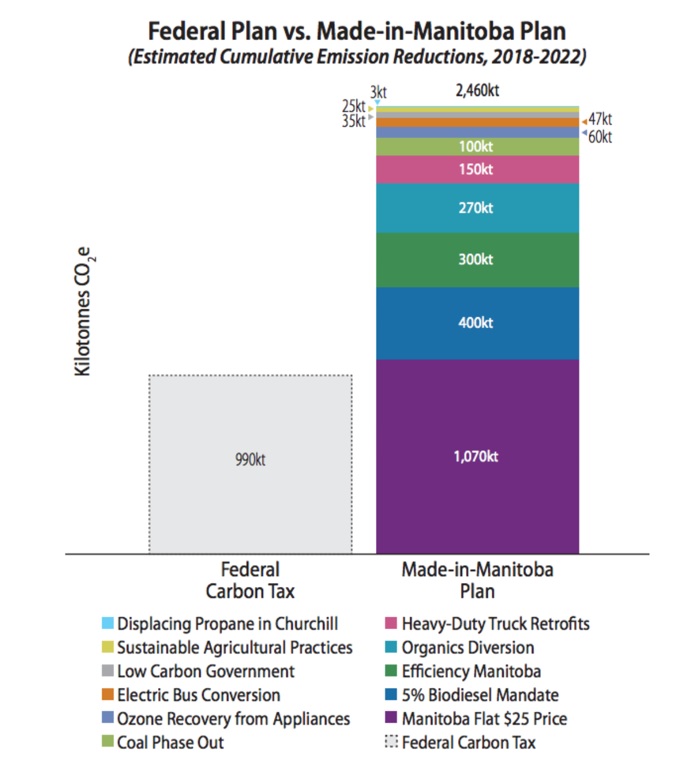
Brian Pallister chooses his own path for carbon pricing in Manitoba
The news from last week: Manitoba is moving forward with its own Made-in-Manitoba Climate and Green Plan. Kudos to Manitoba and the Pallister government for stepping up on carbon pricing and putting forward a plan that seems to have support from a broad set of interests. But how do the details stack up? How far does it move the province forward? And how does it fit into the Pan-Canadian Framework?
Carbon pricing is front and centre
Carbon pricing is a key part of the Plan. In 2018, Manitoba will implement a $25 per tonne carbon price. The price will create incentives for businesses and households to reduce emissions. It gives them flexibility to identify the ways of reducing emissions that make the most sense (and cost the least) given their own circumstances. Overall, there’s no cheaper way to reduce GHG emissions.
At the same time, Manitoba has also indicated it will adopt an “output-based” approach to carbon pricing for large emitters. And that make sense too: the approach ameliorates concerns around carbon pricing and competitiveness. It means that firms will have incentive to reduce GHG emissions by improving their performance, not by shifting production to jurisdictions with weaker policy.
Complementary policies have a role too
The Plan also lays out a series of other policies to drive further emissions reductions in the province. How those policies will perform will ultimately depend on details of the policies, which Manitoba has not yet defined. Still, in many cases, the complementary policies laid out in the Plan are consistent with Ecofiscal’s advice on complementary policies.
For example, the Plan rightfully considers a range of potential policies for the agriculture sector, including an offset system. Given the importance of agricultural emissions in Manitoba, but also the challenge of pricing diffuse, non-combustion agricultural emissions directly under the system, additional policies can fill gaps in the carbon pricing system.
On the other hand, some additional policies in the Plan might be high-cost. Increasing the biodiesel mandate to 5%, for example, might be an expensive way to reduce GHG emissions. There isn’t a clear justification for policy to prefer a specific emissions-reducing technology, such as renewable fuels. In general, technology-neutral policy can drive emissions reductions at lower cost.
A question of stringency
Much of the media coverage around the Plan has focused on the level of the carbon price, set to $25 per tonne CO2e… and not set to rise over time. Here, Manitoba has introduced something different to the table, and it’s worth unpacking.
Good news: Going straight to $25 per tonne (rather than starting slow, and ramping up more gradually) means the policy will drive additional emissions reductions in the shorter term. A higher carbon price drives more emissions reductions by creating stronger incentives to avoid the tax. And in the short-term, Manitoba’s price will be higher than provinces accepting the federal backstop.
Bad news: Staying at $25 means that the policy will drive fewer emissions reductions in the longer-term than would a carbon tax that rises to $30 in 2020, $40 in 2021, and $50 in 2022, the pricing trajectory defined under the Pan-Canadian Framework (PCF). By creating expectations for a lower carbon price in the future, it also might reduce benefits of low-carbon innovation that a gradually rising carbon price can also create.
The Manitoba Plan attempts to square this circle by introducing the idea of cumulative emissions reductions. Rather than annual emissions reductions, it considers the total emissions reductions from 2018 to 2022. The figure below compares estimates of cumulative emissions reductions under the Manitoba Plan and a federal carbon tax that rises over time. According to the Manitoba modelling, going to a higher carbon price, earlier, drives sufficient emissions reductions to justify staying at that price.

A carbon price following the federal backstop price path would reduce emissions by 990 kt (cumulative) from 2018-2022 (grey stack on left). The flat Manitoba carbon price would reduce emissions by 1070 kt over the same period (bottom, purple stack on the right). (Source: Manitoba Climate and Green Plan modelling).
Complications for provincial policy coordination
This cumulative emissions frame has interesting implications for how Manitoba’s Plan fits into the Pan-Canadian Framework on Climate Change and Clean Growth.
In terms of environmental outcomes, we shouldn’t shrug off the idea of cumulative emissions reductions: after all, it’s the total GHG emissions in the atmosphere, not annual emissions that drive costly impacts of climate change. Of course, that argument only works once. Ultimately, we are concerned with ambitious, long-term emissions reductions. Moving beyond 2022, Manitoba itself commits to deeper emissions reductions in the Plan; its “implementation” section promises to link policy action to ambition. Eventually, that will require more stringent policy.
In terms of economic outcomes, relying on carbon pricing will help minimize costs of emissions reductions within the province. But to minimize costs across the country, we will have to move toward a common carbon price over time. Differences between cap-and-trade systems linked to California and carbon taxes that aren’t have already complicated harmonization. Manitoba’s consideration of cumulative emissions reductions adds another twist.
In terms of political outcomes, it gets interesting. Clearly the made-in-Manitoba price is lower than the price required under the PCF, or at least it will be in 2020. That introduces a clear point of contention between Manitoba and the federal government, and raises some questions. How do we measure “compliance” with the PCF? Year-by-year? Over a broader compliance period? Let’s just say that the PCF’s promised 2020 and 2022 review processes will be… exciting.
A step in the right direction
Overall, the Manitoba government should be congratulated on recognizing a need to reduce GHG emissions and putting forward a serious plan to do so, with carbon pricing at the centre to minimize costs. More will clearly be required over time, but the same is true of other provinces as well. Manitoba’s policy is further evidence that the path to coordinated, cost-effective climate policy in a federalist Canada might not be a straight line. But it’s nice to see progress nonetheless.




Comments are closed.